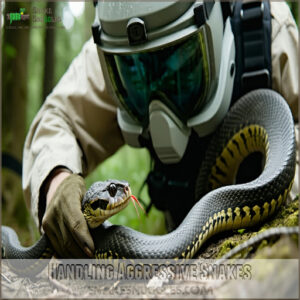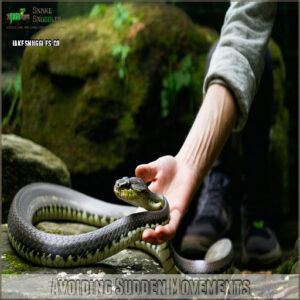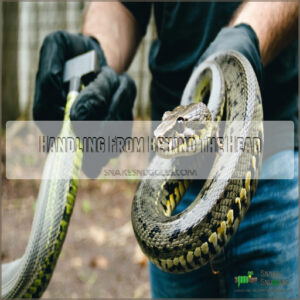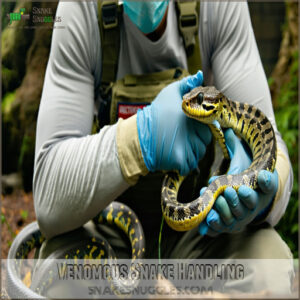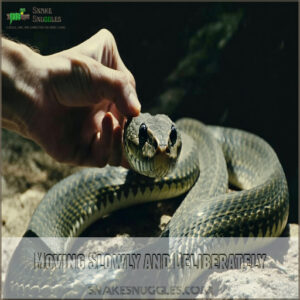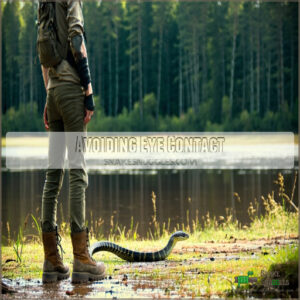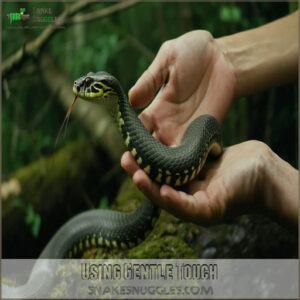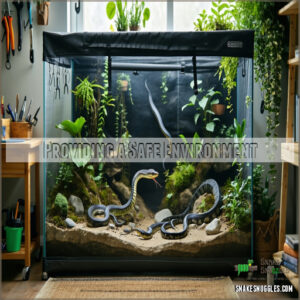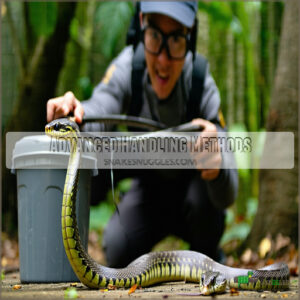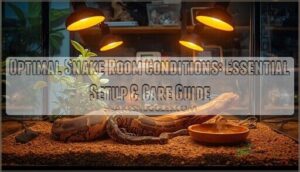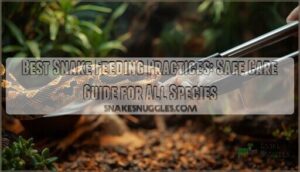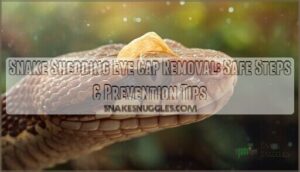This site is supported by our readers. We may earn a commission, at no cost to you, if you purchase through links.
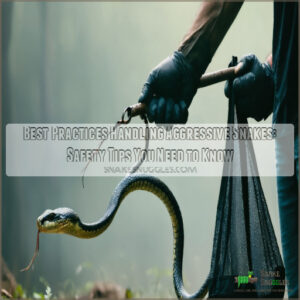
Take a slow, steady approach to avoid provoking defensive behavior, and be aware of their body language: coiling, hissing, or raising their head are warning signs.
Use the right tools like snake hooks and gloves, and always have a secure snake bag ready.
Keep your wits about you, move with purpose, and you’ll handle most situations safely.
Now, let’s explore more detailed tips to keep you and the snake safe.
Table Of Contents
- Key Takeaways
- Handling Aggressive Snakes
- Safe Handling Techniques
- Venomous Snake Handling
- Snake Handling Best Practices
- Advanced Handling Methods
- Frequently Asked Questions (FAQs)
- How do you handle a snake?
- What makes a good snake handler?
- How to master snake handling techniques?
- How to handle venomous snakes safely?
- How to handle a snake ethically?
- Can you handle snakes safely?
- How to handle an aggressive snake?
- What are the rules for handling snakes?
- What does God say about handling snakes?
- How to grab an aggressive snake?
- Conclusion
Key Takeaways
- Stay calm and move slowly: A deliberate, unhurried approach keeps both you and the snake relaxed and calm. Avoid sudden actions that may trigger defensive behavior.
- Use the right tools: Snake hooks, gloves, and protective gear are essential for your safety and the snake’s comfort. Always inspect your equipment before handling.
- Pay attention to body language: Learn to recognize warning signs such as coiling, hissing, or a raised head. This helps you understand the snake’s temperament and avoid provoking defensive reactions.
- Handle from behind the head: Master head control methods by gently grasping behind the head with a firm but not tight grip. Combine this with proper body support to minimize stress for both you and the snake.
Handling Aggressive Snakes
When handling aggressive snakes, you need to stay calm and use the right tools to guarantee safety. A slow, steady approach helps reduce stress and prevents sudden reactions.
Identifying Aggressive Behavior
Spotting aggressive snake behavior starts with reading their body language, looking for aggressive posturing like coiling, hissing, or raising their head.
Defensive signs, such as intense staring or puffing up, signal stress factors, and paying attention to snake behavior patterns—tremors or sudden movements—often indicate discomfort.
Recognizing these threat displays helps you understand their temperament and avoid triggering defensive behavior.
When handling snakes, wearing snake handling gloves is essential for protecting yourself from potential bites.
Using Proper Equipment
Using the right snake handling equipment is non-negotiable.
Always inspect your tools before use.
Here’s what you need:
- Snake hooks and gloves for safe handling.
- Snake bags to secure the snake temporarily.
- Protective suits or gear to avoid bites.
- Handling tools like tongs for distance control.
Prioritize safety precautions every time.
It’s vital to follow proper snake handling techniques to minimize risks.
Approaching The Snake Safely
Approaching an aggressive snake safely starts with a calm approach and solid snake awareness.
Always assess its defensive behavior—coiling, hissing, or striking.
Stick to proven snake handling techniques: move slowly, avoid sudden gestures, and respect its space.
Risk assessment is key; don’t rush.
Following proper snake safety protocols guarantees you minimize danger while maintaining control over the situation.
Supporting The Snake’s Body
Once you’ve approached safely, focus on supporting the snake’s body.
Use gentle lifting and proper alignment to maintain snake balance.
Avoid squeezing—secure grip doesn’t mean tight grip.
Body restraint should be firm but kind, reducing stress.
Aggressive snake behavior often eases when handling safely, so practice snake handling techniques that follow snake safety protocols for everyone’s protection.
Safe Handling Techniques
When handling aggressive snakes, staying calm and using the right techniques can make all the difference.
You’ll need steady hands, sharp focus, and the proper tools to guarantee both your safety and the snake’s well-being.
Avoiding Sudden Movements
Aggressive snake behavior often stems from fear, not malice.
Sudden strikes can happen if you spook them with quick movements.
Stick to slow motions and maintain a calm demeanor.
A smooth approach in a quiet environment helps reduce defensive behavior.
Watch the snake’s body language—gentle handling keeps both you and the snake safer, avoiding unnecessary stress or attacks.
This approach emphasizes the importance of calm demeanor in interactions with snakes.
Maintaining a Safe Distance
Keeping a safe distance is your first line of defense when dealing with aggressive snake behavior.
Respect their personal space to avoid triggering defensive behavior.
Here’s how:
- Safe Zone Creation: Stay at least one snake-length away.
- Proximity Alerts: Watch for sudden movements or coiling.
- Distance Measurement: Use snake hooks or tongs to maintain boundaries.
Understanding snake handling safety is essential for preventing accidents and ensuring secure encounters.
Stay alert and cautious!
Watching for Warning Signs
Snakes don’t shout, but their body language speaks volumes.
Watch for defensive cues like a raised head, coiling, or hissing.
These warning behaviors signal stress or potential attack.
Spotting these early can save you trouble.
| Warning Sign | What It Means |
|---|---|
| Raised Head | Defensive behavior |
| Coiling | Ready to strike |
| Hissing | High stress levels |
| Rapid Tongue Flicking | Heightened alertness |
Handling From Behind The Head
When handling aggressive snakes, mastering head control methods is critical.
Gently grasp behind the head using safe snake handling techniques, ensuring a firm but not overly tight grip.
Combine this with proper body support to reduce stress.
Always prioritize snake restraint tools like hooks for added safety.
Gentle handling and safe grip techniques minimize risk, keeping both you and the snake secure.
Venomous Snake Handling
Handling venomous snakes requires the right tools, protective gear, and a calm, focused approach to stay safe. You can’t afford mistakes, so always prioritize caution and preparation.
Recognizing Venomous Species
Spotting venomous species is key to snake bite prevention.
Learn to recognize poisonous traits like triangular heads, slit-like pupils, or distinctive patterns.
- Rattlesnakes buzz and sport diamond shapes on lighter bodies.
- Coral snakes flash red-on-yellow bands—remember, “red on yellow, you’re a dead fellow.”
- Water moccasins reveal white mouths and stand their ground near water.
Understanding pit viper characteristics is essential for effective snake identification.
Snake identification saves lives.
Wearing Protective Gear
Spotting venomous species is one thing; staying safe around them is another.
Protective gear is your best ally, with thick gloves made from puncture-resistant materials shielding your hands, while safety boots and a protective vest guard against strikes.
Eye protection like safety glasses or face shields keeps venom out of your eyes.
Always suit up; it’s your first defense.
Using Snake Hooks and Tongs
Protective gear is great, but tools like snake hooks and tongs are your real MVPs for safe snake handling.
Use hooks to control movement and tongs for secure restraint, always opting for puncture-resistant materials.
Practice hook techniques and tongs handling with experts to build confidence.
Remember, slow, steady movements are key to avoiding accidents during aggressive snake handling.
When selecting equipment, consider investing in high-quality snake hook tools to guarantee effective and safe snake control.
Seeking Medical Attention
If a snake bite happens, stay calm—it’s key to slowing venom spread.
Keep the bite below heart level, remove tight items, and clean the wound gently.
Immediate medical attention is critical, so know antivenom access points in advance.
Snake bite first aid and a quick emergency response can save lives.
Don’t wait—time matters in a medical emergency.
Snake Handling Best Practices
When handling aggressive snakes, you’ve got to stay calm and move with purpose. Slow, steady actions and proper techniques keep both you and the snake safe.
Moving Slowly and Deliberately
When dealing with aggressive snakes, rushing is your worst enemy.
A deliberate approach with slow movement techniques keeps both you and the snake calm.
Sudden actions trigger defensive behavior, making things risky fast.
For further guidance, review these snake handling safety tips.
Steady breathing and a calm demeanor signal you’re not a threat.
Gentle handling paired with patience builds trust and guarantees safer snake behavior management during handling.
Avoiding Eye Contact
Locking eyes with a snake can feel intense, but it’s a mistake.
Direct eye contact may amplify defensive behavior, as aggressive snakes interpret it as a threat.
Instead, focus on their body orientation and calming signals like slow movements.
Pay attention to snake gaze shifts and facial expressions—these subtle cues help you read snake body language and avoid triggering defensive postures.
Using Gentle Touch
A calm approach matters when handling aggressive snakes.
After avoiding eye contact, use a gentle touch with a soft grip to keep stress low.
Quiet movements and slow lifting help the snake feel secure.
Rushing or squeezing can trigger defensive behavior.
Safe snake handling techniques prioritize humane snake handling, ensuring both you and the snake stay unharmed, and a calm approach is crucial for this.
Providing a Safe Environment
Creating a safe environment isn’t just about avoiding bites—it’s about snake welfare too.
Use secure snake enclosures with proper locks and breathable materials.
Prioritize habitat design by mimicking natural settings, adding hiding spots, and maintaining temperature and humidity.
Environmental enrichment reduces stress, minimizing defensive behavior.
Stick to safety protocols and snake handling precautions to guarantee both you and the snake stay safe.
Advanced Handling Methods
When handling aggressive snakes, advanced techniques can make all the difference in staying safe. You’ll need the right tools, teamwork, and a sharp eye for stress signals.
Working With Large Constrictors
Large constrictors like retics and anacondas aren’t your average pet.
Constrictor safety demands a strict routine.
Keep these giants in a locked, escape-proof enclosure with a thick branch and a big water bowl.
No windows or screens – they’re strong!
Feed them dead rats, not Fluffy.
Keep kids close.
And never handle alone.
One helper per five feet of snake is best.
Constrictor snakes need space, a calm environment, and gentle handling.
Using Specialized Equipment
For maximum safety when using snake handling techniques, consider specialized equipment.
High-tech enclosures with monitoring systems enhance observation and safety precautions.
Employ innovative handling tools, such as telescoping snake hooks with ergonomic grips, and puncture-resistant gloves made of specialized materials.
Prioritize safety gear like precision tongs with padded restraints for a tactical approach.
Remember, proper equipment selection guarantees safe and effective handling.
Handling Snakes With a Partner
Beyond specialized tools, partner handling is key, especially with feisty snakes.
Team coordination and partner communication are your dynamic duo here.
- Establish clear safety protocols beforehand.
- One person manages snake restraint while the other navigates.
- Practice dual handling with calmer snakes first.
- Coordinate movements–it’s a dance, not a wrestling match.
- Partner handling boosts both safety and snake behavior management.
Effective snake handling requires understanding snake behavior patterns to minimize risks and guarantee a safe experience.
Recognizing Stress Signals
Staying alert for stress signals is key to snake behavior management.
Aggressive snakes give clear warnings, from defensive posturing (coiling, raising their heads) to aggression triggers like intense eye contact and hissing.
Tremors and color changes are other behavioral cues.
Keep a safe distance and watch for these signs to guarantee you’re ready for any defensive behavior.
Frequently Asked Questions (FAQs)
How do you handle a snake?
You’ve got your eyes on a scaly friend, but are unsure how to handle a snake.
It’s natural to feel curious and cautious.
Before you begin, get to know the snake’s species and behavior.
Move slowly, use tools like hooks and gloves, and always wear protective gear.
What makes a good snake handler?
A good snake handler is calm, confident, and slow-moving.
You know your stuff: species, behavior, and safety gear.
You’re alert for warning signs, keeping a safe distance, and always learning.
Stay humble, and know when to call a pro.
How to master snake handling techniques?
Snake handling is an art honed with knowledge and a calm, confident approach.
Learn species, their body language, and triggers.
Move slow, support their body, avoid eye contact, and always use protective gear.
How to handle venomous snakes safely?
Identifying venomous snakes is key.
Learn their body language, move slow, and use the right gear: gloves, glasses, and boots.
Avoid sudden moves, handle from behind, and know your antivenom access.
How to handle a snake ethically?
Ethical snake handling means taking a slow, calm approach.
You want to avoid stressing the snake—move gently, use tools, and give them space.
Always wear protective gear and know your snakes.
Can you handle snakes safely?
Yes, you can handle snakes safely, but it’s not for the faint of heart.
It takes a cool head, a slow hand, and the right gear.
Knowing snake behavior and safety prep is key to avoiding bites and keeping the snake stress-free.
How to handle an aggressive snake?
Handling an aggressive snake? Take it slow, stay calm, and give ’em space.
Use snake hooks, avoid eye contact, and handle from behind.
Keep a safe distance, and don’t startle ’em.
What are the rules for handling snakes?
Here are the rules for handling snakes: Move slow, no sudden moves, and use the right gear.
Always approach from behind, keep a safe distance, and watch for warning signs.
Know your snakes and their behavior, stay calm and confident.
What does God say about handling snakes?
God didn’t write a handbook on snake handling, but the Bible does offer a warning: ‘Be wise as serpents and innocent as doves.
It’s a reminder to respect these creatures and approach with caution.
How to grab an aggressive snake?
Here’s the scoop: You don’t want to grab an aggressive snake by surprise.
First, identify its species and assess its behavior.
Use hooks to handle it calmly and slowly, giving the snake space.
Conclusion
Handling aggressive snakes is no easy feat, but with the right knowledge and tools, you can stay safe and keep the snake calm.
Remember, every encounter is unique, so stay alert and adapt your approach, and always prioritize safety.
Keep learning, stay cautious, and you’ll be a pro at handling even the feistiest of serpents, and always respect the snake’s space, which will help you master the art of handling snakes and ensure that you’ll both make it out unscathed with a good understanding of snake calm.
- https://reptilesupershow.com/snake-handling-safety-tips-for-secure-encounters/
- https://reptileapartment.com/treating-aggression-in-snakes/
- https://www.reptiles.swelluk.com/help-guides/aggressive-snake-handling-guide/
- https://snakesnuggles.com/handling-snakes/
- https://ufwildlife.ifas.ufl.edu/safely_dealing_with_snakes.shtml

